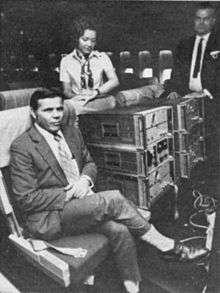Joseph C. Hafele

Joseph Carl Hafele (25 July 1933 – 15 November 2014)[1] was an American physicist best known for the Hafele–Keating experiment,[2][3] a test of Einstein's theory of general relativity.[4]
Hafele was an apprentice welder when he was drafted to serve in the army during the Korean War. After the war, he obtained undergraduate and graduate degrees from the University of Illinois at Urbana-Champaign, earning his PhD in 1962 with a thesis on a topic in nuclear physics. He married Carol Hessling in 1958, and they had four daughters. He worked at Los Alamos National Laboratory, and then Washington University (1966-1972) in the period during which the Hafele-Keating experiment was performed.[5] He later worked at Caterpillar, Eureca College, NASA (Langley Air Force Base), and Christopher Newport University.[6] After his retirement in 1996 he and his wife lived in Laramie, Wyoming, where he continued theoretical work on the interpretation of experiments that might indicate anomalies in relativity.[7]
References
- ↑ http://www.laramieboomerang.com/articles/2014/11/21/obituaries/doc546d73ab1aad6652848025.txt Retrieved 21 November 2014
- ↑ Hafele, J. C.; Keating, R. E. (July 14, 1972). "Around-the-World Atomic Clocks: Predicted Relativistic Time Gains". Science. 177 (4044): 166–168. Bibcode:1972Sci...177..166H. doi:10.1126/science.177.4044.166. PMID 17779917.
- ↑ Hafele, J. C.; Keating, R. E. (July 14, 1972). "Around-the-World Atomic Clocks: Observed Relativistic Time Gains". Science. 177 (4044): 168–170. Bibcode:1972Sci...177..168H. doi:10.1126/science.177.4044.168. PMID 17779918.
- ↑ Time, October 18, 1971
- ↑ Popular Mechanics, January 1972, p. 30
- ↑ http://www.astronomy.net/forums/blackholes2/messages/4289.shtml
- ↑ Dmitri Rabounski and Larissa Borissova, "In Memoriam of Joseph C. Hafele (1933–2014)," Progress in Physics 11 (2015) 136